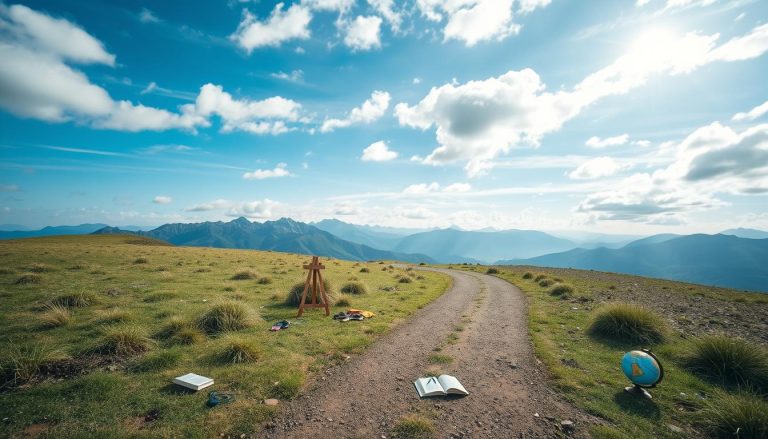Bonsai is an ancient Japanese art that grows miniature trees in small containers. It requires patience, attention to detail, and a deep respect for nature. This art form not only creates living works of art but also teaches us about growing a successful business.
By carefully nurturing and shaping these small trees, bonsai enthusiasts create beautiful displays. These displays show the beauty of balance, control, and small spaces.
Key Takeaways
- Bonsai is an ancient art form that originated in China and was refined by the Japanese over a thousand years ago.
- Bonsai cultivation requires careful attention to factors like climate, growth patterns, and maintenance to select the appropriate tree species.
- Meticulous pruning, wiring, and training techniques are essential for shaping bonsai trees into visually stunning miniatures.
- Bonsai philosophy is deeply rooted in Zen Buddhism, emphasizing principles of balance, control, and embracing imperfections.
- Engaging in bonsai cultivation offers therapeutic benefits such as stress relief, mindfulness, and developing patience.
Understanding the Ancient Art of Bonsai
The art of bonsai has a long history, starting over a thousand years ago in China. It was known as “penjing” and later perfected by Japanese horticulturists. This art became a key part of samurai culture in the Edo period.
Origins and Cultural Significance
Bonsai evolved from a simple gardening hobby to a respected art form in Japan. It is deeply connected to Zen Buddhism. This philosophy values balance, patience, and the bond between humans and nature.
The Philosophy Behind Miniaturization
Bonsai reflects the Zen concept of wabi-sabi, which sees beauty in imperfection. It focuses on the beauty of simplicity. Bonsai artists carefully shape trees to create a balanced and peaceful scene.
Zen Principles in Bonsai Practice
Bonsai is closely linked to Zen Buddhism. It values simplicity, patience, and the connection between nature and humans. Bonsai artists use these principles to create a calm and reflective environment.

“The true essence of bonsai is not found in the plant itself, but in the meditative process of its cultivation and the spiritual connection it fosters between the artist and nature.”
| Bonsai Fact | Value |
|---|---|
| Bonsai trees can live for decades or even centuries | Becoming treasured family heirlooms |
| The Ficus retusa bonsai, known as the “Brooklyn Botanic Garden bonsai,” is over 1,000 years old | A testament to the longevity of these miniature wonders |
| Bonsai trees require specific environmental conditions to thrive | Adequate sunlight, humidity, and protection from extreme temperatures |
| Some bonsai trees can bear tiny fruits and flowers | Enhancing their aesthetic appeal |
Art of Bonsai: Essential Tools and Materials for Bonsai Cultivation
To grow a healthy bonsai, you need the right tools and materials. This includes everything from pruning shears to bonsai pots. Each item is vital for creating a miniaturized tree. Choosing and using these tools correctly can make a big difference.
The basic tools for bonsai care include pruning scissors and heavy duty Chinese shears. You also need concave branch cutters, knob cutters, and a root rake/spatula. For bigger trees, use root cutters up to 270mm to cut thick roots.
Some bonsai lovers also get specialized tools. These include trunk splitters, coir brushes, and turntables for easy tree rotation. Rotary tools are for carving deadwood, and chopsticks help with repotting. Wound sealant prevents infections on carved parts.
Choosing the right bonsai pot is important. It should match the tree’s style and size and have good drainage. Mesh screens cover the drainage hole to prevent soil loss and root rot.
The soil mix is also key. It usually has Akadama, organic compost, pumice, and fine gravel. This mix drains well and gives nutrients for healthy growth.

Having the right tools is crucial for bonsai care. Quality tools help keep your bonsai healthy and beautiful for years.
Selecting the Perfect Tree Species as Art of Bonsai
Choosing the right bonsai species is key to your tree’s success. The world of bonsai offers many options, each with its own needs. From the tough Juniper to the graceful Ficus, there’s a lot to explore.
Popular Bonsai Tree Varieties
- Juniper: A great pick for beginners, Juniper bonsai trees like the Chinese Garden Juniper (Juniperus procumbens ‘Nana’) do well outside and can handle mistakes.
- Ficus: Perfect for indoor bonsai, Ficus species like Ficus microcarpa and Ficus retusa need high humidity and warm spots.
- Japanese Maple: Known for their beautiful fall colors, Japanese Maples are great for bonsai. The Kiyohime Maple is a small variety that does well in USDA Zones 6 to 9.
- Chinese Elm: These trees are easy to shape and grow slowly, making them a favorite for bonsai lovers in USDA Zones 5 to 10.
Climate Considerations
When picking a bonsai, think about the climate. Trees like Pine do well in USDA Zones 3 to 8. Others, like Weeping Fig and Jade, prefer warmer Zones 10 and 11. Knowing what your tree needs is crucial for its health.
Growth Characteristics
Look at the tree’s growth habits too. Things like leaf size, trunk shape, and how it branches affect its look and care. Experts say beginners should start with species like Juniperus procumbens ‘Nana’ to learn faster.

“Choosing the right bonsai tree is like selecting the perfect canvas for your artistic vision. Each species offers unique challenges and rewards, so it’s essential to understand their needs and characteristics before making your selection.”
– Hal Johnson, President of the Long Island Bonsai Society
The Art of Bonsai: Fundamental Techniques
Learning bonsai art means knowing key techniques for shaping and caring for these small trees. Pruning is key to keep the tree small and looking good. It also helps the tree grow new leaves and branches.
Wiring branches is another important step. It lets growers shape the tree’s growth direction and shape. This is how bonsai trees get their unique look.
Repotting bonsai trees is a careful process. It helps the roots grow without getting too big. This keeps the tree healthy and growing well.
- Pruning: Regular pruning is essential to maintain the size and shape of bonsai trees. Growers must carefully trim branches and foliage to encourage new growth and prevent the tree from becoming overgrown.
- Wiring: Wiring the branches of a bonsai tree allows growers to guide the direction and curvature of the plant’s growth, shaping it into the desired form.
- Repotting: Regularly repotting bonsai is crucial to manage the tree’s root development and prevent it from becoming rootbound. This process must be carried out with great care to ensure the tree’s continued health and vitality.
Getting good at bonsai takes time and patience. It also needs a good understanding of how trees grow. With practice, gardeners can make beautiful bonsai that show the beauty of nature in a small way.
| Technique | Purpose | Key Considerations |
|---|---|---|
| Pruning | Maintain size and shape | Identify healthy branches, avoid over-pruning |
| Wiring | Guide branch growth | Avoid damage, remove wires at the right time |
| Repotting | Manage root development | Timing, soil composition, root trimming |
By mastering these bonsai techniques, gardeners can create and maintain healthy, visually stunning bonsai that reflect the beauty and essence of nature in miniature form.
“The true essence of bonsai is not found in the tree itself, but in the mind of the artist who cultivates it.”

Art of Bonsai: Mastering Pruning and Shaping Methods
Pruning and shaping are key in bonsai art. Bonsai pruning balances width, depth, and height by removing branches. It keeps trees healthy by removing dead wood and pests. But, too much pruning can hurt the tree, and too little can cause uneven growth.
Branch Pruning Techniques
Using high-quality shears is vital for bonsai pruning. Make precise cuts for fine pruning with steel shears. Clean your tools often to avoid rust. Different trees need different pruning methods.
Deciduous trees like Maple need frequent pruning. Conifers like Pine need more careful pruning.
Root Pruning Basics
Pruning shapes and structures the tree. Find the leader branch and shape the tree’s silhouette. This creates balance and harmony.
Working with bonsai trees makes them into living art. This art brings peace and thoughtfulness.
Wiring and Training Methods
Wiring shapes bonsai trees into beautiful silhouettes. Use aluminum or copper wire for its gentle yet strong hold. Refine branches and foliage carefully for a stunning look.

“The true essence of bonsai is to shape living trees in miniature, cultivating them with patience and precision to create a living work of art.”
Soil, Watering, and Fertilization Guidelines of Art of Bonsai
Keeping your bonsai trees healthy means paying close attention to their soil, water, and food. The right bonsai soil mix is key. It should include akadama, pumice, and lava rock for good drainage, moisture, and air.
How often to water your bonsai depends on the tree, pot size, and where it’s kept. Watch your bonsai closely and adjust the bonsai watering as needed. The soil should stay moist but not soggy or too dry.
Regular bonsai fertilization is vital for growth. From spring to mid-autumn, use a balanced fertilizer. This helps your bonsai grow strong, with good foliage, roots, and colors.
- Use a mix of akadama, pumice, and lava rock for well-draining yet moist soil.
- Change how often you water based on the tree, pot, and environment.
- Fertilize often during the growing season with a balanced fertilizer for your bonsai.
“Proper soil, watering, and fertilization are the foundation for a thriving bonsai garden.”
Following these key tips will help your bonsai trees thrive. This lets you enjoy the beauty and peace of these small wonders.
Creating Aesthetic Balance and Design in Art of Bonsai
Bonsai is more than just growing plants. It’s about creating beautiful, small worlds that feel like nature. Artists aim to make these tiny scenes look perfect, using special styles and rules.
Traditional Bonsai Styles
Bonsai has many styles, each with its own look. You can see tall, straight trees or ones that curve naturally. There are even styles that look like waterfalls or forests, showing off the artist’s skill.
Proportion and Scale
Getting the size right is key in bonsai. The tree should look like a full-grown tree but small. Every part, from the trunk to the leaves, must fit together perfectly.
Visual Harmony Principles
Artists use special rules to make bonsai look good. They think about where to put branches and how to use empty space. This makes the bonsai look real and peaceful.
“In bonsai, the goal is not to merely create a miniature tree, but to capture the essence of nature’s grandeur in a small, living sculpture.”
Learning bonsai design lets artists turn trees into amazing art. They use special styles and rules to make these tiny worlds. This way, bonsai fans can enjoy the beauty of nature in a new way.
Art of Bonsai: Seasonal Care and Maintenance
To keep bonsai trees healthy, you need to know how to care for them in each season. The temperature, daylight, and humidity change all year. By adjusting your care to meet these changes, your bonsai will stay beautiful and strong.
In spring, bonsai trees start growing again. They need more water and food to grow well. Some trees need special care with water, so watch them closely.
Summer is hot, and bonsai trees can dry out fast. Place them in the right spot to get morning sun and afternoon shade. Check the soil every day to keep the roots moist but not too wet.
Fall is the best time to prune and repot bonsai trees. Pruning and wiring help shape the tree. Root pruning and repotting keep the tree healthy. Some trees, like Japanese Maples, show off their colors in fall before going dormant.
Winter brings cold and frost. Trees from warm places need to stay inside or have a heater. Watch for pests and diseases and adjust watering to keep the tree alive during this time.
By changing your care to fit the seasons, you can keep your bonsai trees healthy. From more water in spring to protecting them in winter, each season has its own needs.
Seasons:
| Season | Bonsai Care Considerations |
|---|---|
| Spring |
|
| Summer |
|
| Fall |
|
| Winter |
|
Knowing how to care for bonsai trees in each season is key. From more water in spring to protecting them in winter, each season has its own needs. By following these tips, you can keep your bonsai trees healthy and beautiful.
Art of Bonsai: Common Challenges and Solutions
Cultivating bonsai trees needs patience, dedication, and solving many challenges. Pests, diseases, and environmental stressors can harm these tiny wonders. Careful attention is key to keeping them healthy and beautiful.
Pest Management
Bonsai trees face pests like spider mites, scale insects, and aphids. These pests can damage the leaves and branches. It’s important to check for them often and treat them quickly.
Using insecticides or natural solutions like neem oil can help. But, some chemicals might not be allowed.
Disease Prevention
Diseases like root rot and fungal infections can harm bonsai trees. Good watering, air flow, and soil conditions are essential. This helps prevent diseases.
Ensuring roots get oxygen and soil drains well prevents root rot. Good air flow stops fungal diseases from spreading.
Environmental Stress Factors
Bonsai trees are very sensitive to their environment. Extreme temperatures, bad lighting, or wrong humidity can hurt them. The right growing conditions are crucial.
Protecting from harsh weather, giving the right sunlight, and keeping humidity right helps. This keeps the bonsai healthy and looking great.
| Challenge | Symptoms | Solutions |
|---|---|---|
| Aphid Infestation | Leaves and new growth covered in sticky, honeydew-like substance | Regular inspection, use of insecticidal soap or neem oil, increasing beneficial predator populations |
| Root Rot | Wilting, yellowing leaves, mushy or discolored roots | Improving soil drainage, reducing watering frequency, treating with fungicides if necessary |
| Extreme Temperatures | Scorched or wilted leaves, stunted growth | Providing shade or protection from harsh sunlight, insulating the bonsai pot during cold weather |
Understanding and tackling common bonsai pests, diseases, and environmental stress factors is vital. This way, bonsai lovers can keep their trees healthy and beautiful. They will continue to bring joy for many years.
Conclusion
Bonsai is a mix of gardening and art. It needs patience, precision, and knowledge of plants and beauty. By mastering bonsai mastery, people create tiny, natural wonders. Bonsai is also a way to relax and learn more about nature.
The beauty of bonsai is how it adds peace and a link to nature. The bonsai art form has grown over time, blending old and new styles. It started in China and Japan, now it’s loved worldwide for its unique living sculpture look.
Working with bonsai is a journey of growth and caring for the environment. It teaches us about the balance between nature and us. Bonsai shows us the beauty and strength of life in every form.






